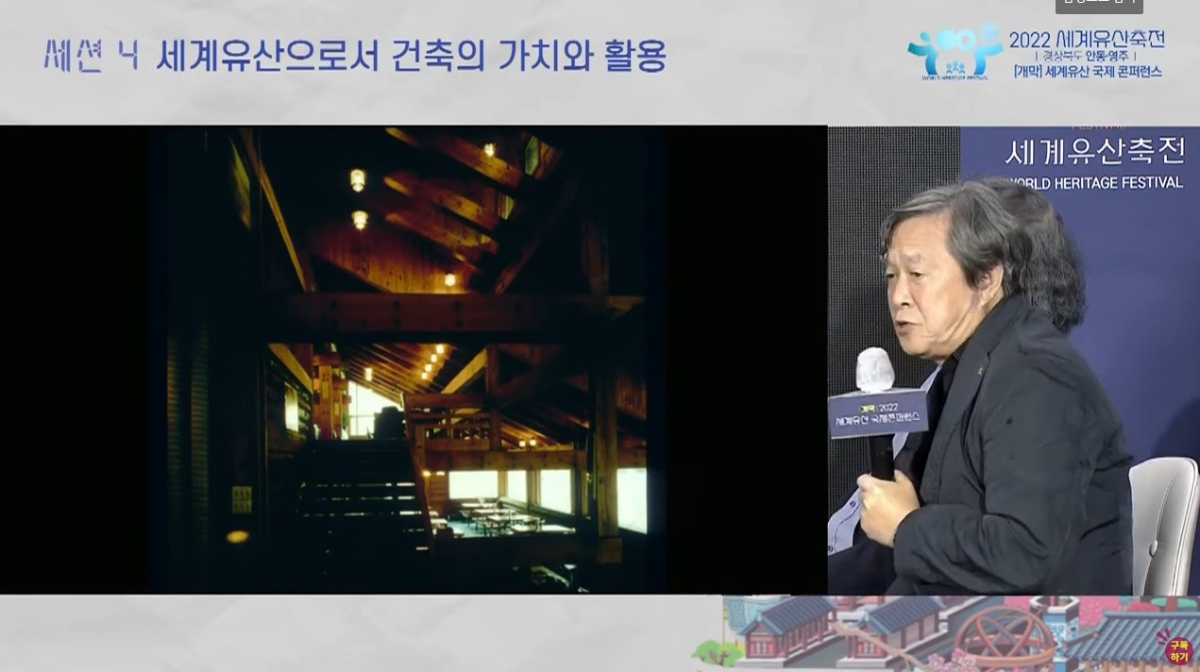The 2022 World Heritage International Conference was held for two days on Sep. 3 ‒ 4 to mark the opening of the third 2022 World Heritage Festival: Andong, Youngju Gyeongsangbuk-do hosted by the Cultural Heritage Administration of Korea and organised by the Korea Cultural Heritage Foundation. The theme was ‘World Heritage, Old Newness’ at the Sosu Seowon Confucian Academy Chunghyo Education Center, and the entire event was broadcast live on YouTube. Tadao Ando, who gave the keynote lecture, introduced the notion of architecture gaining vitality as a heritage site through the examples of Naoshima Island and Museum San. ‘History does not come back’, he noted, reminding everyone of our collective responsibility to cherish World Heritage as inheritances for the next generation.
The first session covered conservation issues before contending with the novelty of World Heritage. In particular, Stephan Doempke (chairman, World Heritage Watch) reported on the problematic situation he found while investigating the status of World Heritage in each country. A recent Russian attack on Ukrainian cultural heritage site destroyed a total of 168 sites, and this analysis assessed the damage on surrounding World Heritage. In response, he proposed adding to The World Heritage Convention an agreement reporting the status of each country’s cultural heritage sites.
In the second session, under the theme of ‘An Artistic Interpretation of World Heritage and the Creation of Future Heritage Sites’, works that were reinterpretations World Heritage took primary focus. Among them, the presenter Simon Morley (professor, Dankook University) gave an impressive speech as part of an introduction to the work, asking essential questions about how we might view the legacy left by the exploitation of capital by the ruling class in the past. The third session, ‘Relishing and Spreading the Values of World Heritage through Digital Communication’, explored the possibility of enjoying World Heritage and works created by applying such categories through digital technology.
In the final discussion, Han Kyungkoo (secretary-general, the Korean Committee for UNESCO) expressed sympathy for professor Simon Morley’s critical point of view and said that the discrimination underlying Neo-Confucianism should be reestablished from a modern perspective and then used as the basis for new invention.
The discussion at the fourth session that followed the next day was consider where one might locate the present value of Korean architecture in terms of World Heritage and how that value can continue to be reflected in modern architecture. While examining Hahoe Village or Buseoksa Temple, the panelists agreed that the madang space left empty for the relationship between oneself and others, or the arrangement with the axis twisted to face nature, was complimented for its considerate gesture. As an example of efforts to reflect this in modern times, Ryu Choonsoo (principal, BEYOND SPACE GROUP) introduced the Hangyeryeong Service Area designed in the 1970s. The wooden structure, which was created by altering the height of the pillars without cutting the existing mountain, became an exterior by itself without risking redundancy. On the other hand, other opinions were expressed concerning that an apartment type is inevitable given the context of a city with high population density. The discussion was concluded with the final assignment that we should all establish an improved relationship with nature in modern urban conditions.

Screenshots from YouTube




